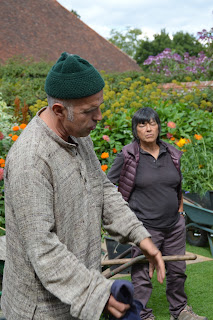Aster Heaven
Asteraceae Heaven
I love December! It always seems like quite a short month really. The days are short. The festivities of Christmas seem to remove at least a week from the month itself and no sooner is Xmas over with, than the celebrations of New Year commence. Also, my birthday is in December. So, whilst the month itself launches us deep into winter 'proper' I never mind it too much.
But 'why' I hear you cry am I banging on about December and Christmas here at the start of September? Well ** tenuous link warning ** recently I went on a study day at Great Dixter. I visit Dixter quite regularly and have written about the place a few times in my posts. I've also attended quite a few of the study days there, looking closely at Exotic Planting, Successional Planting, and the Plants of the AGM - Award of Garden Merit. However, this time it was... drum roll please...... Daisy Day at Dixter! A comprehensive look at the many plants of the asteraceae family! Yes! This was a day I had been looking forward to for a very long time indeed. A day I had imagined and longed for, hoping that one day this group of plants would be looked at closely on such a day as this. So yes, I really did feel as though all my Xmas's and birthdays had come at once when I first found out the day. See what I did there?
 |
| Marina Christopher at home on her nursery |
I've never made any secret of my love of daisies. Through the work I do, the gardens I visit and maintain, as well as my writings, I must've written more about daisies than any other group of plants. In fact, it was walking past a garden on my way to work every day, observing a yellow clump of Rudbeckia come into life each year - and watching that clump get slowly bigger each year - that got me into horticulture in the first place. I mean, I know it's now something of a one-trick pony, but the grouping of perennial daisies (Rudbeckia, Helenium, Echinaceae etc) with a variety of grasses is a great start to any garden design of merit. Throw in a the odd Persicaria, the Ghost of Miss Willmott, some Verbenas and Veronicastrum, and voila! A garden design worthy of any show.
The day itself was hosted by Marina Christopher, nursery owner of Phoenix Perennials and author of Late Summer Flowers - a fantastic book that has never left my bedside table. Interestingly enough, she mentioned how her publishers dissuaded her from having a yellow-flowered cover to her book, citing that a yellow jacket on a gardening book would never sell in the U.K, due to our national dislike of yellow flowers. I, like Marina, can never understand the aversion British gardeners have towards bright yellow. I think it's a gift from the gods, given at a time of year when we desperately need a bit of brightness to our borders. Anyway!
 |
| Where all the magic happens |
So, in the beauty of one of Dixter's wooden-beamed rooms, with a log fire burning, Marina gave an impressive display of her knowledge of all things asteraceae. A comprehensive variety of specimens was run through, together with a wealth of facts and information on this huge genus. As she grappled - quite literally - with the Eupatoriums, perennial Sunflowers, tall Rudbeckias, Achilleas, Cornflowers, Echinops, Dahlias etc... she also seamlessly ran through various facts, tips and anecdotes about all these plants.
 |
| Towering Verbena hastata |
 |
| Fergus - always willing to illustrate his knowledge |
After a superb lunch was given in the barn, it was off and into the garden for an asteraceae tour of the grounds with both Fergus & Marina. Of course, Dixter being Dixter, there were countless specimens to be discovered there. Fergus would have us stop and look closely at various Asters, Inulas - including the majestic 'Magnifica', loads of Rudbeckias, Dahlias, perennial Sunflowers, Liatris, Vernonias...... and so many more! Seeing how they worked in the borders, in combinations with other plants is probably the best way to appreciate the usefulness of these late-season favourites. I tend to use them almost exclusively with grasses or with taller dot plants, such as Verbenas, Ricinus and Cleomes. But I get the feeling that at Dixter they are used in a more traditional way, planted into traditionally mixed borders, backed by shrubs, and therefore, not so tied to the more contemporary, naturalistic way of planting.
 |
| Aster heaven at Great Dixter |
 |
| 'Dahlia heads as big as this!' |
 |
| A gorgeous carrot would you believe ?? |
Until next time! Thanks for reading.
All the best
Marc
Le Jardinier




Hey there, that's was great post, wonderful information here, thanks for share, even If you want to enhance the beauty of your garden, choose from the wide variety of fauna offered by our exotic plant nursery Sussex. We at Athelas Plants have created a name for offering the widest range of shrubs, trees and grasses and other plants to suit your individual requirements and preferences. http://www.athelasplants.co.uk/
ReplyDelete